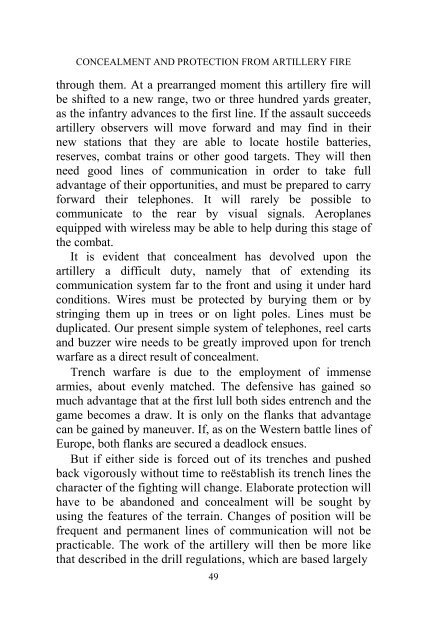the field artillery journal - Fort Sill - U.S. Army
the field artillery journal - Fort Sill - U.S. Army
the field artillery journal - Fort Sill - U.S. Army
Create successful ePaper yourself
Turn your PDF publications into a flip-book with our unique Google optimized e-Paper software.
CONCEALMENT AND PROTECTION FROM ARTILLERY FIRE<br />
through <strong>the</strong>m. At a prearranged moment this <strong>artillery</strong> fire will<br />
be shifted to a new range, two or three hundred yards greater,<br />
as <strong>the</strong> infantry advances to <strong>the</strong> first line. If <strong>the</strong> assault succeeds<br />
<strong>artillery</strong> observers will move forward and may find in <strong>the</strong>ir<br />
new stations that <strong>the</strong>y are able to locate hostile batteries,<br />
reserves, combat trains or o<strong>the</strong>r good targets. They will <strong>the</strong>n<br />
need good lines of communication in order to take full<br />
advantage of <strong>the</strong>ir opportunities, and must be prepared to carry<br />
forward <strong>the</strong>ir telephones. It will rarely be possible to<br />
communicate to <strong>the</strong> rear by visual signals. Aeroplanes<br />
equipped with wireless may be able to help during this stage of<br />
<strong>the</strong> combat.<br />
It is evident that concealment has devolved upon <strong>the</strong><br />
<strong>artillery</strong> a difficult duty, namely that of extending its<br />
communication system far to <strong>the</strong> front and using it under hard<br />
conditions. Wires must be protected by burying <strong>the</strong>m or by<br />
stringing <strong>the</strong>m up in trees or on light poles. Lines must be<br />
duplicated. Our present simple system of telephones, reel carts<br />
and buzzer wire needs to be greatly improved upon for trench<br />
warfare as a direct result of concealment.<br />
Trench warfare is due to <strong>the</strong> employment of immense<br />
armies, about evenly matched. The defensive has gained so<br />
much advantage that at <strong>the</strong> first lull both sides entrench and <strong>the</strong><br />
game becomes a draw. It is only on <strong>the</strong> flanks that advantage<br />
can be gained by maneuver. If, as on <strong>the</strong> Western battle lines of<br />
Europe, both flanks are secured a deadlock ensues.<br />
But if ei<strong>the</strong>r side is forced out of its trenches and pushed<br />
back vigorously without time to reëstablish its trench lines <strong>the</strong><br />
character of <strong>the</strong> fighting will change. Elaborate protection will<br />
have to be abandoned and concealment will be sought by<br />
using <strong>the</strong> features of <strong>the</strong> terrain. Changes of position will be<br />
frequent and permanent lines of communication will not be<br />
practicable. The work of <strong>the</strong> <strong>artillery</strong> will <strong>the</strong>n be more like<br />
that described in <strong>the</strong> drill regulations, which are based largely<br />
49

















